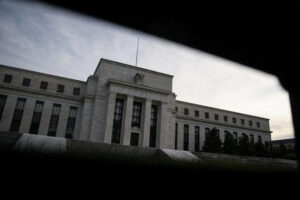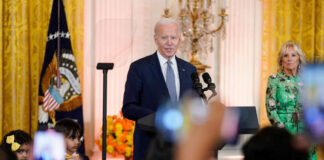JULY 27, 2022

WASHINGTON, D.C. — The Federal Reserve continued a sprint to reverse its easy-money policies by approving another unusually large interest rate increase and signaling more rises were likely coming to combat inflation that is running at a 40-year high.
Officials agreed Wednesday to a 0.75-percentage-point rate rise, which will lift their benchmark federal-funds rate to a range between 2.25% and 2.5%. The rate increase won unanimous backing from the 12-member rate-setting committee.
In a policy statement after the conclusion of their two-day meeting, officials acknowledged signs of slower economic activity since they met last month. “Recent indicators of spending and production have softened. Nonetheless, job gains have been robust in recent months,” the statement said.
The statement repeated language from previous meetings that said officials anticipate additional rate increases will be appropriate. Fed Chairman Jerome Powell is set to speak at a news conference at 2:30 p.m. Eastern time.
Fed officials are raising rates at the most aggressive pace since the 1980s and have approved increases at four consecutive policy meetings, starting in March when they lifted rates from near zero. Until last month, the central bank hadn’t raised rates by 0.75 point since 1994.
With Wednesday’s action, the central bank has raised rates since March as much as it did between 2015 and 2018 and returned the fed-funds rate to a level last seen three years ago, before a slowing economy led the Fed to cut rates slightly. Officials slashed them to zero in March 2020, when the Covid-19 pandemic raced around the world.
U.S. inflation has accelerated since March 2021. Demand surged after the economy’s reopening and aggressive government stimulus, and Russia’s invasion of Ukraine has further aggravated supply-chain disruptions and driven energy and commodity prices up this year.
Officials at their June meeting agreed they likely needed to raise rates to at least 3% this year and to levels high enough to slow economic growth, which could send the unemployment rate up.
How consumers and businesses respond to tighter money will help resolve one of the biggest questions facing the Fed and financial markets: how high officials will ultimately raise rates.
Another hot inflation reading earlier this month—the Labor Department reported its consumer-price index rose 9.1% in June from a year before—prompted investors to speculate that the Fed might increase the fed-funds rate by a full percentage point at this week’s meeting. The Fed targets 2% inflation on average and uses a separate gauge, the personal-consumption expenditures price index.
Investors in interest-rate futures markets are also betting that after raising the rate to around 3.5% at the end of this year, the Fed will reverse course next year by lowering it. Mr. Powell hasn’t publicly discussed such a possibility, and instead has said the central bank needs to see convincing evidence that monthly inflation figures are declining before dialing back rate increases to more traditional quarter-point increments.
Inflation diminished last summer “and then turned right around and went back up,” Mr. Powell said at a press conference last month. “So I think we’re going to be careful about declaring victory.”
Since the Fed raised rates by 0.75-point last month, several other central banks have accelerated their own rate increases. Investors have responded in ways that reflect growing worries about a recession. Oil and commodity prices have tumbled. So have market-based measures of future inflation and bond yields.
The fed-funds rate, an overnight rate on loans between banks, influences borrowing costs throughout the economy, including rates on mortgages, credit cards and business loans. Rate increases slow the economy and cool inflation by reducing asset prices and raising borrowing costs, which damps investment, hiring and spending.
The housing market, as one of the most interest-rate sensitive corners of the economy, has been the epicenter of the Fed’s effort to stimulate growth last year and to slow it this year. Prices have surged amid strong demand, but sales are slumping now as rates rise sharply.
The Mortgage Bankers Association reported Wednesday that the average 30-year fixed mortgage rate stood at 5.74% last week, holding close to 14-year highs. The National Association of Realtors separately said Wednesday that an index measuring contracts signed to purchase existing homes fell 8.6% in June from May and was 20% below the level from a year earlier.










































































































